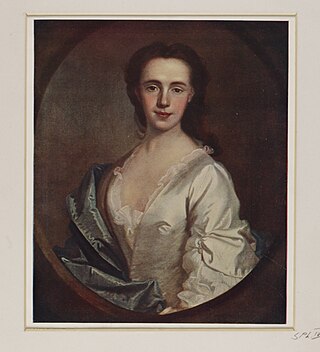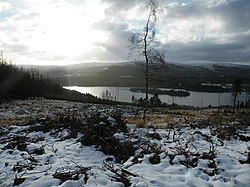
Clan Shaw is a Highland Scottish clan and is a member of the Chattan Confederation.

Clan Farquharson is a Highland Scottish clan based at Invercauld and Braemar, Aberdeenshire, and is a member of the Chattan Confederation.

Clan Chattan is a unique confederation of Highland clans. The clan is distinctive in highland clan history in that it was acknowledged to be a community or confederation, of twelve separate Scottish clans, who each had their own clan chief recognized under Scottish law, but who were united under and bound to a superior chief of the confederation for mutual solidarity, sustenance and protection in the Middle Ages and early modern period in the Scottish Highlands.

Clan Macpherson is a Highland Scottish clan and a member of the Chattan Confederation.

Anne Mackintosh (1723–1784) was a Scottish Jacobite leader, who was the wife of Angus Mackintosh, Chief of the Clan Mackintosh. She was one of very few (apparent) female military leaders during the Jacobite rising of 1745 and the first female to hold the rank of colonel in Scotland.

Clan Cameron is a West Highland Scottish clan, with one main branch Lochiel, and numerous cadet branches. The Clan Cameron lands are in Lochaber and within their lands lies Ben Nevis which is the highest mountain in the British Isles. The Chief of the clan is customarily referred to as simply "Lochiel".

Clan Davidson is a Highland Scottish clan and a member of the Chattan Confederation.

Clan MacBean, is a highland Scottish clan and is a member and historic sept of Clan Chattan.
The Mackintoshes of Borlum were a cadet branch of the Clan Mackintosh, a Scottish clan of the Scottish Highlands. Their most famous member was Brigadier William Mackintosh, Laird of Borlum (1658–1743) usually known as Mackintosh of Borlum who was a leader of the Jacobite rising of 1715.
Brigadier William Mackintosh of Borlum (1658–1743), often referred to simply as Mackintosh of Borlum, was a leader of the Jacobite rising of 1715.

The Battle of Invernahavon was a Scottish clan battle between the Clan Cameron and the confederation of Clan Chattan that consisted of the Clan Mackintosh, Clan Macpherson, and Clan Davidson amongst others. Some sources give the date as 1386, others as 1370.

The Stand-off at the Ford of Arkaig occurred in September 1665 at Achnacarry, about 10 miles (16 km) northeast of Fort William, Scotland. The Chattan Confederation led by the Clan Mackintosh assembled an army to challenge Clan Cameron in a 360-year-old dispute over the lands around Loch Arkaig. After a week of stalemate, the long-running feud was ended by a deal in which the Camerons bought the land from the Mackintoshes.

Tor Castle is a ruined castle, about 3 miles north east of Fort William, Highland, Scotland, west of the River Lochy and east of the Caledonian Canal, near Torlundy.

The Battle of Craig Cailloch was a Scottish clan battle fought in 1441 between the Clan Cameron and Clan Mackintosh. The two clans had defected from Alexander of Islay, Earl of Ross during his war with James I of Scotland. Alexander lost the war but was subsequently appointed Justiciar of Scotia by James and became reconciled to the Chattans. Alexander encouraged the Chattans to invade the lands of the Camerons which resulted in a battle on Craig Cailloch in 1441. The battle was bloody and several leading Chattan men were killed. Afterwards Malcolm Mackintosh led further raids into Cameron territory to avenge the deaths. Donald Dubh, leader of the Camerons was later forced into exile in Ireland.
The Mackintoshes of Killachie were a minor noble Scottish family and the senior cadet branch of the Clan Mackintosh, a Scottish clan of the Scottish Highlands. Their most famous member was James Mackintosh who was a Scottish jurist, Whig politician and historian.
Malcolm Beg Mackintosh was the tenth chief of the Clan Mackintosh, a Scottish clan of the Scottish Highlands. He was also chief of the confederation of clans known as the Clan Chattan.
Lachlan Beg Mackintosh, 14th of Mackintosh was the chief of the Clan Mackintosh, a Scottish clan of the Scottish Highlands. He was also chief of the confederation of clans that was known as the Clan Chattan.
Duncan Mackintosh, 11th of Mackintosh was chief of the Clan Mackintosh, a Scottish clan of the Scottish Highlands. He was also chief of the confederation of clans that was known as the Clan Chattan.
Ferquhard Mackintosh, 12th of Mackintosh was the chief of the Clan Mackintosh, a Scottish clan of the Scottish Highlands. He was also chief of the confederation of clans known as the Clan Chattan.
William Mackintosh, 13th of Mackintosh was the chief of the Clan Mackintosh, a Scottish clan of the Scottish Highlands. He was also chief of the confederation of clans that was known as the Clan Chattan.
















